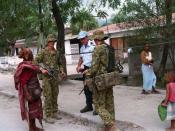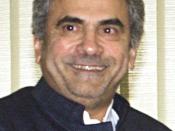The film Punitive Damage directed by Annie Goldson is a powerful narrative that tells the story of a courageous young man, a mother's quest for truth and justice and the tragedy of the situation in East Timor. The beginning of this documentary contains many important features that help to introduce the ideas, storylines and atmosphere. Some of these features are the soundtrack, visual techniques, camera angles and characters. Assisted by executive producer Gaylene Preston, cinematographer Leon Narbey, and sound designer Mike Hopkins, Goldson has produced a complex and powerful film.
The film opens with white captions on a black background with the magnified and dramatic sound of typewriting which instantly captures the audiences attention. The date, 12th November 1991, are the first words to appear so we know immediately when this documentary is set. The captions also introduce Max Stahl and the massacre he has filmed. The typewriting sound effects fade out and screams, sirens and gunshots are heard which prepare us for the visuals we are about to see.
We are then presented with powerful and shocking footage of the 1991 Dili massacre. It is within a small window and the rest of the screen is black. This is a strong contrast with the jerky camera movements and the blackness also suggests death, danger and people hiding and scared. Because the footage is jerky we know the camera was hand-held which adds authenticity and reminds the audience that what they are seeing is real.
The screen then switches to a photograph of Kamal as there is a voiceover, "...fears for a New Zealander caught in a massacre...". Although we do not know who Kamal is yet, the voiceover links the massacre with the boy in the photograph and also lets the audience know that he is a New...


